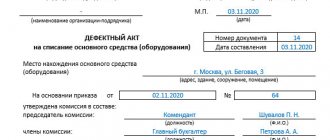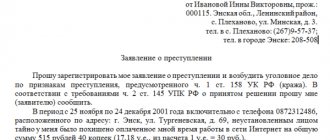Theft in the form of theft (Article 158 of the Criminal Code of the Russian Federation) indicates an encroachment on someone else's property. These are secret actions to seize something to which the criminal has no legal right. There is corpus delicti only in the absence of the owner’s consent to such alienation.
This act is inextricably linked with causing damage, because The citizen loses, along with the property, the opportunity to exercise his rights to use and dispose of it, and the seizure of property itself occurs free of charge. The purpose of theft is to cause damage.
In order to compensate it, it is necessary to file a civil claim within the framework of criminal proceedings (Article 44 of the Code of Criminal Procedure of the Russian Federation). But in order to qualify for compensation and return of your funds, you must prove the fact of harm and its extent. The evidence is a timely completed theft report. This is the main basis for imposing sanctions on an unscrupulous employee. Most often, such documents have to be drawn up at a construction site or at an enterprise. In the first case, thefts most often occur; in the second, strict corporate control over employees is established.
Note!
Do not confuse inventory acts, which record the fact of a shortage, and an act of theft, which indicates a socially dangerous act.
A particular difficulty is the lack of an established template. Since this document in most cases must be presented to the court as evidence of guilt, when drawing it up it is necessary to adhere to a number of unspoken rules. We will tell you which ones exactly in our article.
Report on absence of employee and loss of property
If an employee does not show up at his workplace, and the fact of the loss of company property is recorded, it is necessary to properly document both events. Management has the right to entrust the drawing up of an absenteeism report to the personnel service. Another option is to file a report from the boss of the missing employee addressed to the director of the enterprise.
The act specifies:
- FULL NAME. absent employee;
- his position;
- exact time of absence from work;
- information about witnesses;
- date of;
- signature of the compiler and witnesses.
Counting on the evidentiary value of this act, it is necessary to take care of the internal standards of the enterprise. An employee cannot be required to be at the workplace if a job description has not been adopted regarding him. If an employee holds a position within a structural unit of an enterprise (department, section), it is necessary to adopt regulations on the work of the unit. Otherwise, you risk that the truancy document will not be accepted by the court as relevant and admissible evidence.
The theft of property report is an optional document that should form the basis of your complaint to the police. It is necessary in order to notify management of a violation of the law, so you can draw up a report addressed to the director.
If there is an inventory report of property indicating a shortage, there is no need for an official document about the loss. As a rule, based on the results of the inventory, a specialized commission is convened (if provided for by the internal documents of the enterprise), which records the theft. Based on the commission’s materials about the inspection, it is also necessary to write a statement to the police.
When and what is TORG-15 used for?
If a product or material value is broken, deteriorated or broken, TORG-15 is used: what it is is stated in detail in Resolution of the State Statistics Committee No. 132 of December 25, 1998.
Damaged inventory items must be written off, discounted or disposed of, and this procedure must be validated. The damage report reflects the cause and amount of damage and notes the guilty party, if identified. IMPORTANT!
The guilty employee compensates for the organization’s losses from his own income. If the culprit is not identified, the damage is written off and reflected in the non-operating expenses of the enterprise.
The write-off procedure is carried out by a special commission (appointed by a separate order). The commission includes a director (he becomes the chairman of the commission), financially responsible employees and other employees. If necessary, representatives of sanitary supervisory authorities are involved. TORG-15 should reflect all members of the commission indicating their positions.
The commission indicates the cause of damage, the cost of damage and reflects the identified defects. In addition, it is necessary to determine the possibility of further use of goods, materials, and valuables. The options are:
- sale at actual cost;
- markdown;
- recycling, etc.
If inventory items have only partially lost their consumer properties, they are discounted with the possibility of further sale. In the damage report, two values are recorded - before and after markdown. Separately reflect the amount of such markdown.
If inventory items are completely damaged and have lost their consumer properties, they cannot be sold. In this case, in addition to the act of damage, TORG-16 is drawn up - an act of write-off of goods.
An accountant has the opportunity to make TORG-15 in 1C - in the Enterprise Accounting database. This is an external printed form that is generated for the “Write-off of goods” document. For example, in Trade Management 10.3 software, an act is drawn up with the cost of inventory items already filled in. To connect the act register, you need to add it to the “External printed forms” directory.
Use free instructions from ConsultantPlus experts to write off equipment that has fallen into disrepair.
Report to the police about missing property
The sample application to the police is not approved by the internal documents of the Ministry of Internal Affairs of the Russian Federation; accordingly, there is no single (standard) form. There is no form for reporting theft. In addition, it is not always necessary that it be submitted in writing.
Notification to the police is regulated by the provisions of Art. 141 Code of Criminal Procedure of the Russian Federation. The procedure for reporting a crime provides several options for reporting an incident:
- personal application;
- phone call;
- ordered letter;
- through the Internet.
If you decide to transmit information by phone, the duty officer will record the fact of theft, which is subject to verification only if you introduce yourself, give the address of your actual residence and provide contact information.
If the application is submitted in person or sent by mail, it must be signed. It is also possible to contact the police department in person with an oral statement. As a rule, in such cases, law enforcement officers independently, but under the dictation of the victim, draw up a protocol.
A sample statement to the police requires an appeal to the head of the structural unit of the Ministry of Internal Affairs of the Russian Federation to which the complaint is being filed. In the introductory part it is necessary to indicate not only your full name. the head of the department, but also personal information about yourself (full name, place of registration and actual residence, contact phone number). The application is signed personally by the person submitting it.
Otherwise, you have the right to determine the content of your complaint or incident report yourself. The basis will be an act of theft of property, a copy of which you can attach.
Applications to the police are accepted around the clock, without holidays or weekends. The responsibility for receiving citizens' messages rests with the officer on duty, who cannot refuse to accept a complaint, except in cases of anonymity of the message. The police officer who registers the complaint will not check the circumstances of the theft, only your personal information.
Why is a property damage report drawn up?
A property damage report is a document designed to record:
- The fact of damage to property.
- List of specific damages.
- Presence of a specific culprit for property damage.
- Intention or negligence to cause harm.
The document in question is used in legal practice in connection with many situations. For example, it is drawn up in case of damage/destruction of property:
- during cargo transportation;
- flooding of an office or apartment;
- negligent handling of property (including during rental, rental);
- registration of insurance cases;
- committing various offenses and crimes.
The main purpose of the act is to certify the existence of damage and its nature. It is this document that subsequently serves as the basis for the following actions:
- recovery of compensation for damage voluntarily or through the court;
- applying disciplinary measures to the guilty employee;
- writing off damaged property from the balance sheet.
How to draw up an act correctly - sample filling
Despite the fact that any report on an incident at an enterprise is drawn up in any form, it is necessary to take its execution seriously. First, decide who will be present when it is signed and will thereby confirm the fact of theft or the employee’s absence from the workplace. As a rule, employees of the same enterprise are involved for this purpose - at least 3 people.
There is no need to use the company's letterhead with its details; a regular sheet is sufficient. The title of the document should reveal its contents. It is advisable to include in a separate line the type of document - “ACT”, and below disclose its content - “about the absence of an employee and the loss of property”.
The main text should be concise and contain key information about the event:
- date of theft or truancy;
- circumstances of discovery;
- the exact time of the event or its duration;
- information about the person responsible for absenteeism (guilt will be determined by the court).
Note!
The act records a specific event, which is considered completed at the moment of its signing. If it is long-lasting (absenteeism for several working days), then a separate document must be drawn up for each day the employee is absent.
If the employee eventually appears at the workplace, then he must state in writing the reasons and motives for his action. He is also faced with the question of compensation for the damage caused. If the employee admits to committing the theft, he can sign an agreement to compensate the company for the funds lost. In case of refusal, the only option is to go to court.
Who has the right and should apply?
The act of theft is drawn up in the presence of a specially created commission by the chairman of the commission . As a rule, it consists of at least three people from a given enterprise and their preferred qualifications (a person included in the group must have an idea of the progress of the case and knowledge of the subject of the investigation (you can find out what signs the subject of theft should have here) As a rule, a foreman, engineer, senior storekeeper, accountant, etc. take part).
Recommendations
Even if your company has not had problems with absenteeism, and the audit shows no theft of property, make sure that such situations do not occur in the future. Initially, bring the entire internal regulatory framework of the organization into compliance. Before demanding the performance of duties from employees, it is necessary to clearly formulate these responsibilities and write them down in job descriptions and regulations on the work of departments, sectors, directorates and departments.
An order to dismiss an employee at the initiative of the manager is not a way out of this situation. These actions must be justified, otherwise the decision will be challenged in court, and the company will have to pay compensation.
If a case of absenteeism associated with the theft of property is discovered, it is necessary to record everything as quickly as possible in the appropriate act and file a complaint with the police. It should be clear from the documents what exactly was stolen, who was absent from the workplace and for how long.
Compliance with these requirements will allow you to further protect the interests of the enterprise in court, compensate for damage and punish the guilty employee. If you encounter difficulties in drawing up such papers and bringing internal regulations to the required compliance, contact our qualified lawyers for help. You can by phone or through the form on the website.
The procedure for taking inventory of cash at the cash desk
The procedure for auditing cash at the cash desk consists of the following steps:
- Approval of the composition of the commission in an order using the unified form INV-22 (or similar to it, developed independently).
For an example of a cash inventory order, see ConsultantPlus. Trial access to the legal system is free. - Receiving a receipt from the cashier confirming the absence of unpaid cash and unaccounted for cash documents. The cashier also provides the commission with the latest cash report.
- Recalculation of funds and documents, comparison of the result with accounting, verification of the availability and movement of strict accounting forms with the information reflected in their registration log.
- Registration of inventory results in the INV-15 form.
Attention! The inventory of funds at the cash desk is carried out in the presence of the person financially responsible for the funds (usually the cashier).
Cash inventory in the INV-15 form can be found on our website.








